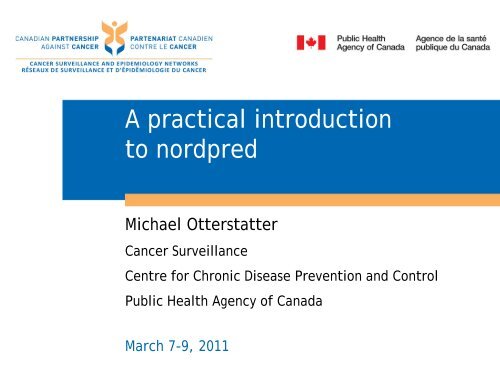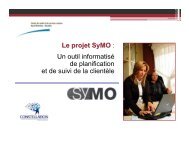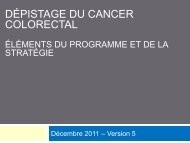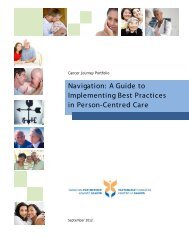A practical introduction to nordpred - cancerview.ca
A practical introduction to nordpred - cancerview.ca
A practical introduction to nordpred - cancerview.ca
Create successful ePaper yourself
Turn your PDF publications into a flip-book with our unique Google optimized e-Paper software.
A <strong>practi<strong>ca</strong>l</strong> <strong>introduction</strong><strong>to</strong> <strong>nordpred</strong>Michael OtterstatterCancer SurveillanceCentre for Chronic Disease Prevention and ControlPublic Health Agency of CanadaMarch 7-9, 2011
ProjectionsAccurate projections are essential for planning……but how best <strong>to</strong> predict future events?2
Projections?3
Many models are available• Poisson regression (classic APC model)• other generalized linear models (power models)• generalized additive models• simple average methods• univariate (ARIMA) & multivariate (VAR) time series• state-space models (Ameri<strong>ca</strong>n Cancer Society)• functional data analysis• Bayesian models (versions of all of the above)4
Practi<strong>ca</strong>l <strong>introduction</strong> <strong>to</strong> <strong>nordpred</strong>This presentation is a <strong>practi<strong>ca</strong>l</strong> <strong>introduction</strong> <strong>to</strong> one approach<strong>to</strong> projections: the <strong>nordpred</strong> package for <strong>ca</strong>ncer projectionsObservedvaluesNORDPREDProjectedvaluesTheoreti<strong>ca</strong>l and philosophi<strong>ca</strong>l considerations are important,but will not be covered here5
The <strong>nordpred</strong> package• R software package that predicts trends in <strong>ca</strong>ncer incidenceusing a version of the traditional age-period-cohort model• written by Harald Fekjær (harald.weedon-fekjaer@kreftregisteret.no)and Bjørn Møller (bjorn.moller@kreftregisteret.no), of the CancerRegistry of Norway• background and example:• Møller B, et al. 2003. Prediction of <strong>ca</strong>ncer incidence in the Nordiccountries: Empiri<strong>ca</strong>l comparison of different approaches. Statistics inmedicine 22:2751-2766• Møller B, et al. 2002. Prediction of <strong>ca</strong>ncer incidence in the Nordiccountries up <strong>to</strong> the year 2020. European Journal of Cancer Prevention11, suppl. 16
The <strong>nordpred</strong> packageAvailable free-of-charge (but see license agreement):www.kreftregisteret.no/en/Research/Projects/Nordpred/Nordpred-software/# Nordpred: R (www.r-project.org) & S-PLUS# (www.insightful.com) functions# for prediction of <strong>ca</strong>ncer incidence (as used in the# Nordpred project)# Written by: Bjørn Møller and Harald Fekjaer# , 2000-2003# Version 1.1. updated <strong>to</strong> correct for wrong estimates# in young age groups# License: GNU version 27
Recent examples of <strong>nordpred</strong>• Coupland, V. H. et al. 2010. The future burden of <strong>ca</strong>ncer in London comparedwith England. Journal of Public Health, 32:83.• Mork, J. et al. 2010. Time trends in pharyngeal <strong>ca</strong>ncer incidence in Norway1981-2005. Cancer Causes and Control, 21:1397• Parkin, D. M. et al. 2009. The potential for prevention of colorectal <strong>ca</strong>ncer inthe UK. European Journal of Cancer Prevention, 18:179.• Aitken, R. et al. 2008. Cancer incidence and mortality projections in NewSouth Wales, 2007 <strong>to</strong> 2011. Cancer Institute NSW.• Olsen, A. H. et al. 2008. Cancer mortality in the United Kingdom: Projections<strong>to</strong> the year 2025. British Journal of Cancer, 99:549.• Parkin, D. M. et al. 2008. Predicting the impact of the screening programmefor colorectal <strong>ca</strong>ncer in the UK. Journal of Medi<strong>ca</strong>l Screening, 15:163.• Ferlay, J. et al. 2007. Estimates of the <strong>ca</strong>ncer incidence and mortality inEurope in 2006. Annals of Oncology, 18:581.• Møller, H. et al. 2007. The future burden of <strong>ca</strong>ncer in England: Incidence andnumbers of new patients in 2020. British Journal of Cancer, 96:1484.• Quinn, M. J. et al. 2003. Cancer mortality trends in the EU and accedingcountries up <strong>to</strong> 2015. Annals of Oncology, 14:1148.8
Basic steps for using <strong>nordpred</strong>1. Reading the <strong>nordpred</strong> package2. Input data3. Generate projections4. Get results5. Plot results6. Explore options9
1. Reading the <strong>nordpred</strong> packageDownload ‘<strong>nordpred</strong>.s’ file <strong>to</strong> preferred working direc<strong>to</strong>ry andread package in Rsetwd("C:/Documents and Settings/My Documents/<strong>nordpred</strong>")source("<strong>nordpred</strong>.s")10
Example #1: Colon <strong>ca</strong>ncer in Norway** Data and code for this example available at <strong>nordpred</strong> website11
2. Input data: structureNumbers of <strong>ca</strong>ncer <strong>ca</strong>sesPopulation sizesFive-year periodsFive-year periodsFive-year age groups0-45-910-1415-1920-2425-2930-3435-3940-4445-4950-5455-5960-6465-6970-7475-7980-8485+58-62 63-67 68-72 73-77 78-82 83-87 88-92 93-97Five-year age groups0-45-910-1415-1920-2425-2930-3435-3940-4445-4950-5455-5960-6465-6970-7475-7980-8485+58-62 63-67 68-72 73-77 78-82 83-87 88-92 93-97Note: there must be 18 five-year age groups in both the <strong>ca</strong>ses/deathsand population data files12
2. Input data: reading in filesCancer <strong>ca</strong>ses or deaths, observedindata
2. Input data: reading in files (continued...)14
2. Input data: reading in files (continued...)Population sizes, observed and projectedinpop1
2. Input data: reading in files (continued...)16
3. Producing projections: overview• Producing projections is a two-step process1. fitting a model <strong>to</strong> the observed data2. generating projections (unknown future values) based on thefitted model• Nordpred allows these steps <strong>to</strong> be separate or combined1. Separate: use <strong>nordpred</strong>.estimate and<strong>nordpred</strong>.prediction functions in sequence2. Combined: use single <strong>nordpred</strong> function17
3. Producing projections: overview (continued...)• Nordpred fits an APC regression model <strong>to</strong> the observed dataCases = (Age) + (Period) + (Cohort) + Period‘drift’ or ‘trend’term<strong>ca</strong>tegori<strong>ca</strong>lvariablescontinuousvariable• Due <strong>to</strong> colinearity among age, period and cohort, lineareffects of period and cohort <strong>ca</strong>nnot be estimatedsimultaneously— a common linear trend (‘drift’) isestimated instead• Predictions assume future cohort and period effects areequal <strong>to</strong> last estimated effect in the fitted model18
3. Producing projections: fit modela. Fit APC regression model <strong>to</strong> input dataest
3. Producing projections: fit model (continued...)20
3. Producing projections: predictb. Generate projected values from fitted modelres
3. Producing projections: prediction outputObserved and predicted valuesX58.62 X63.67 X68.72 X73.77 X78.82 X83.87 X88.92 X93.97 X98.02 X03.07 X08.12 X13.17 X18.220-4 1 0 0 0 0 0 0 0 0 0 0 0 05-9 0 0 0 0 0 0 0 0 0 0 0 0 010-14 1 0 1 1 0 0 0 0 0 0 0 0 015-19 1 0 0 1 3 0 1 3 2 2.2 2.5 2.6 2.520-24 1 4 2 3 3 2 4 3 3.6 3.1 3.4 3.9 425-29 4 1 6 6 6 11 7 7 9.6 9.5 8.9 9.9 11.830-34 13 11 6 12 15 26 14 10 19.9 20.1 19.3 17.5 19.435-39 27 16 18 15 29 22 31 18 24.2 31.1 30.6 28.5 25.940-44 32 37 32 28 40 50 64 71 59.5 51 62.3 59.5 55.445-49 54 75 73 73 75 72 122 112 163 120.5 104.7 122.5 11750-54 66 103 128 139 125 134 185 190 265.7 278.7 210 183.7 212.455-59 105 124 197 210 257 254 230 269 448.5 444 453.9 347.7 311.560-64 189 212 252 283 369 442 446 436 612.6 742.8 738.5 739.5 585.465-69 197 258 303 358 484 603 683 668 785.1 867.2 1047.7 1045.1 1045.470-74 223 286 376 403 554 663 754 880 1003.5 1001 1104.7 1336.8 1356.175-79 192 262 312 402 502 640 775 913 1100.2 1118.9 1121.9 1246 1535.780-84 146 160 215 278 337 415 513 615 780.3 894.6 921.4 937.8 1066.785+ 81 95 122 151 209 278 328 379 549.3 636.6 755.6 830.1 891.6Observed Predicted23
3. Producing projections: prediction outputModel informationPrediction done with:Number of periods predicted (nopred): 5Trend used in predictions (cuttrend): 0 , 0.25 , 0.5 , 0.75 , 0.75Number of periods used in estimate (noperiod): 8P-value for goodness of fit: 0.7Used recent (recent):TRUEP-value for recent: 0.0292First age group used (startuseage): 6First age group estimated (startestage): 524
4. Get results: basic outputa. Projected numbers and rates, with optionspred_num
4. Get results: basic output (continued…)26
4. Get results: basic output (continued…)b. Generate crude and age-standardized ratespredrates_crude
4. Get results: basic output (continued…)crude ratesage-standardizedrates28
4. Get results: basic output (continued…)29
4. Get results: basic output (continued…)c. Generate projected values and export <strong>to</strong> a file# GENERATE PROJECTED VALUESpred
4. Get results: basic output (continued…)c. Generate projected values and export <strong>to</strong> a fileFive year age groupFive year periodX98.02 X03.07 X08.12 X13.17 X18.220-4 0 0 0 0 05-9 0 0 0 0 010-14 0 0 0 0 015-19 2.04 2.19 2.53 2.6 2.5520-24 3.59 3.12 3.35 3.88 3.9725-29 8.72 8.18 7.38 8.06 9.4330-34 16.8 16.17 15.01 13.41 14.6235-39 18.55 22.61 21.57 19.83 17.7740-44 56.4 44.87 52.83 49.85 45.8345-49 153.31 110.05 90.47 103.89 98.0450-54 265.49 272.73 202.67 171.14 194.1655-59 461.84 458.36 463.53 354.79 308.7460-64 658.68 789.19 793.43 792.46 628.4965-69 828.27 958.51 1154 1172.51 1169.3870-74 1008.7 1033.45 1198.54 1454.99 1500.8775-79 1100.34 1140.9 1179.74 1380.22 1706.5780-84 742.88 866.72 914.87 964.69 1153.6985+ 529.27 609.17 739.58 836.86 930.531
5. Plot resultsa. Generate plots of crude and/or standardized ratesplot( res,incidence=TRUE,standpop=NULL,agegroups="all",new=TRUE,lty=c(1,2),col=c(1,1),main="Colorectal Cancer",xlab="Period",ylab="Incidence rate")numbers (FALSE) or rates (TRUE)crude (NULL) or age-stand. rates(vec<strong>to</strong>r of weights)overlay on current plot (FALSE) orcreate a new plot (TRUE)line types (1=solid, 2=dashed, etc.)and colours (1=black, 2=red, etc.)labels for plot, x-axis and y-axis32
5. Plot results (continued…)Colorectal CancerIncidence rate0 10 20 30 40 50X58.62 X68.72 X78.82 X88.92 X98.02 X08.12 X18.2Period33
5. Plot results (continued…)b. Overlaying plotsplot( res,incidence=TRUE,standpop=NULL,agegroups="all",new=TRUE,lty=c(1,2),col=c(1,1),main="Colorectal Cancer",xlab="Period",ylab="Incidence rate")plot( res, incidence=TRUE, standpop=Canada1991,new=FALSE, lty=c(1,2), col=c(2,2))plot( res, incidence=TRUE, standpop=US2000,new=FALSE, lty=c(1,2), col=c(4,4))legend(9, 10, c("Crude rate","Canada 1991", "US2000"), text.col=c(1,2,4))34
5. Plot results (continued…)Colorectal CancerIncidence rate0 10 20 30 40 50Crude rateCanada 1991US 2000X58.62 X68.72 X78.82 X88.92 X98.02 X08.12 X18.22Period35
Producing projections: using a single function• Producing projections is a two-step process1. fitting a model <strong>to</strong> the observed data2. generating projections (unknown future values) based on thefitted model• Nordpred allows these steps <strong>to</strong> be separate or combined1. Separate: use <strong>nordpred</strong>.estimate and<strong>nordpred</strong>.prediction functions in sequence2. Combined: use single <strong>nordpred</strong> function36
6. Exploring <strong>nordpred</strong> options: overviewprojections
6. Exploring <strong>nordpred</strong> options: observed periods3 obs. periods (min)7 obs. periods10 obs. periods38
6. Exploring <strong>nordpred</strong> options: trendCompare projections using recent vs. his<strong>to</strong>ri<strong>ca</strong>l trendproj_recent_trend
6. Exploring <strong>nordpred</strong> options: trendCompare projections using recent vs. his<strong>to</strong>ri<strong>ca</strong>l trendIncidence Rate of Colorectal CaIncidence rate0 10 20 30 40 50His<strong>to</strong>ri<strong>ca</strong>l trendRecent trendX58.62 X68.72 X78.82 X88.92 X98.02 X08.12 X18.22Period40
6. Exploring <strong>nordpred</strong> options: link functionCompare projections using power5 vs. Poisson linkproj_power5
6. Exploring <strong>nordpred</strong> options: link functionCompare projections using power5 vs. Poisson linkIncidence Rate of Colorectal CaIncidence rate0 10 20 30 40 50 60PoissonPower5X58.62 X68.72 X78.82 X88.92 X98.02 X08.12 X18.22Period42
6. Exploring <strong>nordpred</strong> options: choose <strong>ca</strong>refully!Incidence of Colorectal Cancer AmonNumber of new <strong>ca</strong>ses0 2000 4000 6000 8000 10000Poisson linkPower linkomit oldest obs.use recent trenduse cut-trendincrease cut-trendX58.62 X68.72 X78.82 X88.92 X98.02 X08.12 X18.22Period43
Acknowledgment and disclaimerThe Cancer Surveillance and Epidemiology Networks have beenmade possible through a financial contribution from Health Canada,provided by the Canadian Partnership Against Cancer.The views expressed herein do not necessarily represent the views ofthe Canadian Partnership Against Cancer nor that of Health Canada.44
Supplemental information45
Calculation of predicted rates in <strong>nordpred</strong>Projections:1. linear trend component2. non-linear cohort component3. fix period <strong>to</strong> last estimated valueObserved ratesPredicted rates1995-1999 2000-2004 2005-2009exp(A 1 +5⋅D+C 12 +P 5 ) exp(A 1 +6⋅D+C 13 +P 6 ) exp(A 1 +7⋅D+C 13 +P 6 )exp(A 2 +5⋅D+C 11 +P 5 ) exp(A 2 +6⋅D+C 12 +P 6 ) exp(A 2 +7⋅D+C 13 +P 6 )exp(A 3 +5⋅D+C 10 +P 5 ) exp(A 3 +6⋅D+C 11 +P 6 ) exp(A 3 +7⋅D+C 12 +P 6 )exp(A 4 +5⋅D+C 9 +P 5 ) exp(A 4 +6⋅D+C 10 +P 6 ) exp(A 4 +7⋅D+C 11 +P 6 )exp(A 5 +5⋅D+C 8 +P 5 ) exp(A 5 +6⋅D+C 9 +P 6 ) exp(A 5 +7⋅D+C 10 +P 6 )exp(A 6 +5⋅D+C 7 +P 5 ) exp(A 6 +6⋅D+C 8 +P 6 ) exp(A 6 +7⋅D+C 9 +P 6 )exp(A 7 +5⋅D+C 6 +P 5 ) exp(A 7 +6⋅D+C 7 +P 6 ) exp(A 7 +7⋅D+C 8 +P 6 )exp(A 8 +5⋅D+C 5 +P 5 ) exp(A 8 +6⋅D+C 6 +P 6 ) exp(A 8 +7⋅D+C 7 +P 6 )













